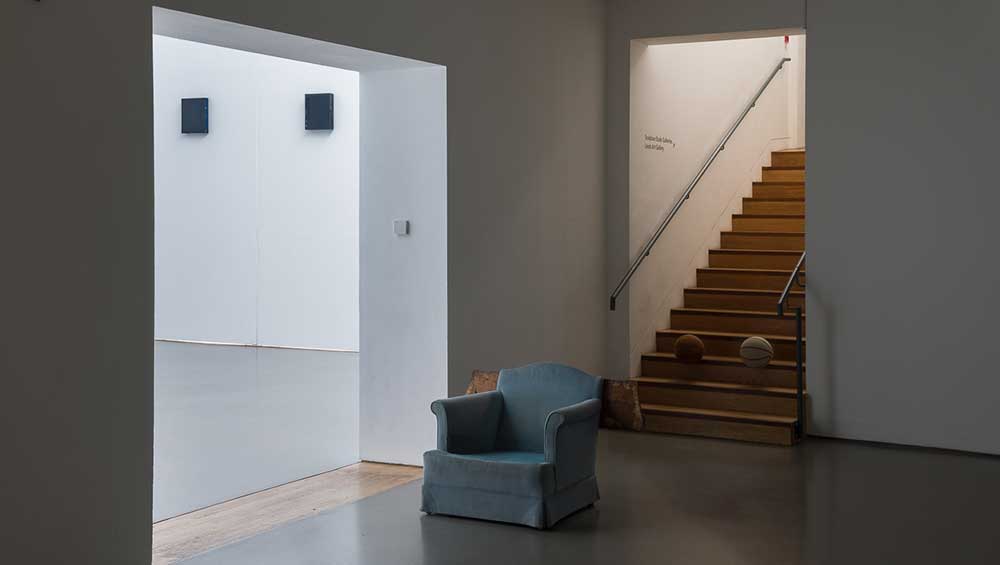
Michael E Smith, installation view, Henry Moore Institute, Leeds.
Henry Moore Institute, Leeds
24 March – 18 June 2023
by VERONICA SIMPSON
I was lured to Leeds by the spirit of spontaneity, anarchy and improvisation promised in the publicity for this, Michael E Smith’s first solo UK show, at the Henry Moore Institute. Selecting from an ever-evolving repertoire of everyday salvaged objects, his sculptures would be entirely configured on site, we were told, in the moment.
There is something delicious in not having a clue about what you are going to find beyond a gallery’s entrance, except something unexpected. Smith (b1977, Detroit) resists prediction and repetition. He doesn’t even visit the site before he makes his choices, but evolves the positioning and placement of the pieces over an intensive five-to-six-day period of all-hours, deep immersion.
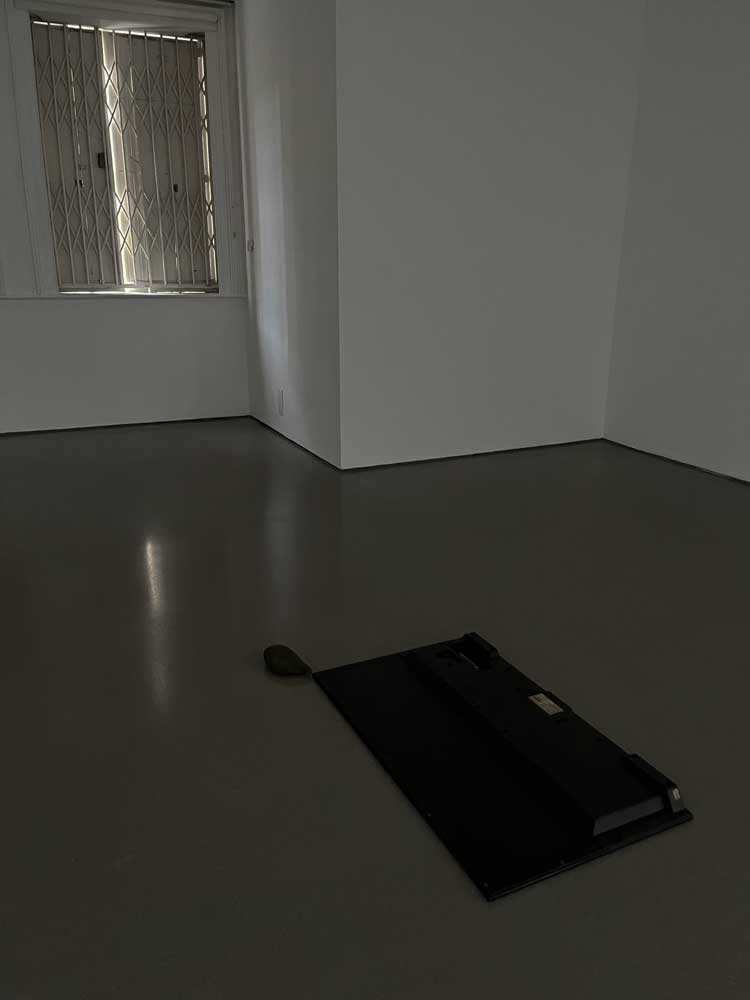
Michael E Smith, Untitled, 2023. Television, rock. Installation view, Henry Moore Institute, Leeds. Photo: Veronica Simpson.
Sure enough, nothing prepared me to enter a room that I had last experienced filled with beautifully lit, atmospheric statues and paintings to see … well, almost nothing. On the floor just beyond the door, lay a discarded dirty black oblong that looked like some kind of flat, plastic portal, but turned out to be a knackered LED-screen TV, face down, paired with a peculiar stone shaped like a comma. The lights were off, the gallery so gloomy that I couldn’t make out what it was. I scanned the room anxiously, to find an anchor point. Ah, there was something I could latch on to, lurking near the stairs: a grubby, pale-blue armchair of indeterminate vintage, the deeper blue of the fabric under its missing seat pad testifying to its use and its uselessness.
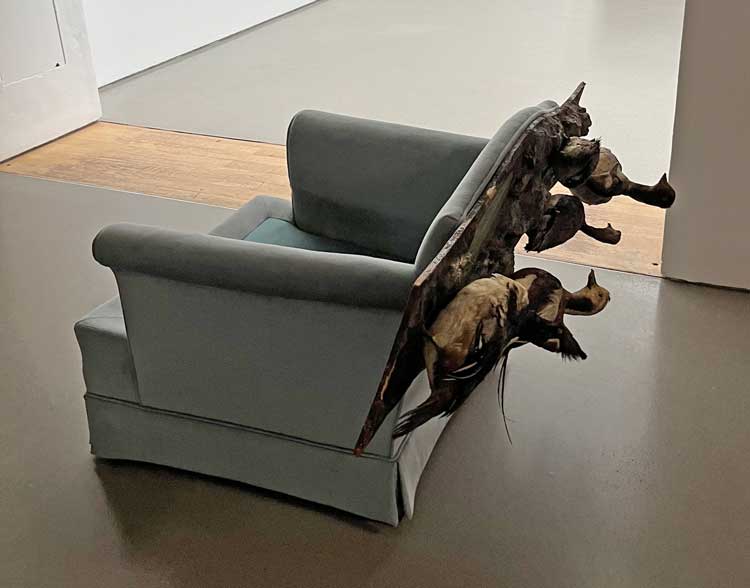
Michael E Smith, Untitled, 2023. Chair, ducks. Installation view, Henry Moore Institute, Leeds. Photo: Veronica Simpson.
But it appeared to have a piece of wood stuck to its back, two edges protruding, like wings, from either side. What was it? A skateboard? A shelf? From a distance, I couldn’t tell. On closer inspection, I found it was a section of timber, with a row of stuffed ducks perkily marching, as if to a pond, but sideways. Surreal. Discomfiting. Behind it, the closest thing to a trademark Smith object: two grubby basketballs, on the stairs. But as I got closer, their precarious positioning was revealed: they were not resting on top of a step, but protruding, as if spiked, on the stair’s edge.
Laurence Sillars, head of the Henry Moore Institute and the curator of this show, reassures me that discomfiture is the desired response. “That sense of mild panic, or something akin to that, that you feel walking into these uncomfortably empty spaces, that’s part of it. It’s all about just tuning in, thinking about your expectation of what you think an exhibition should look like.”
Almost gleefully, Sillars points out how this stripped-back presentation draws what would usually be an unwelcome focus on to the clutter in the ceiling, all the spotlights, fixings, ventilation panels, as well as how slightly grubby and marked these white walls are. The dingy glow of a fire-escape corridor and its emergency lights seeps into the room. This, too, is intentional.
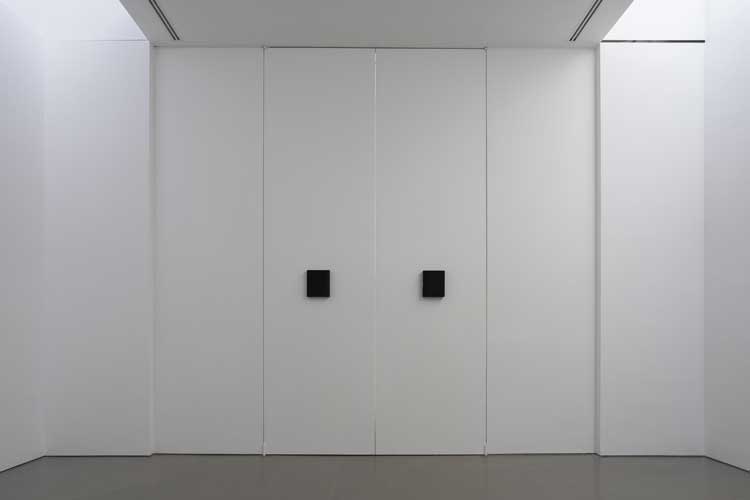
Michael E Smith, BUGS, 2023. DVD player, VCR, window. Installation view, Henry Moore Institute, Leeds.
I have never been so aware of the fabric, the scale and form of a big, white cube space. Devoid of any cues directing your attention to some glassy plinth or framed treasure, you can’t help but notice the grimy film of muck on the long rooflights that track either side of the central gallery ceiling. But what are those two dark oblongs on the far wall? Apparently, one is the guts of a video cassette recorder, the other a DVD player. Not that I would have known by looking at them. They seem like mute, black boxes. Which, of course, they are, as well as being relics of a pre-streaming age. Smith was drawn to place these here because the wall on which they are resting is in fact two panels obscuring a huge window; so, there’s this resonance with looking out, looking in, being looked at – the boxes like two blank eyes. Unusually for Smith, he has titled this work BUGS (usually his work is Untitled, though the materials are always painstakingly detailed).
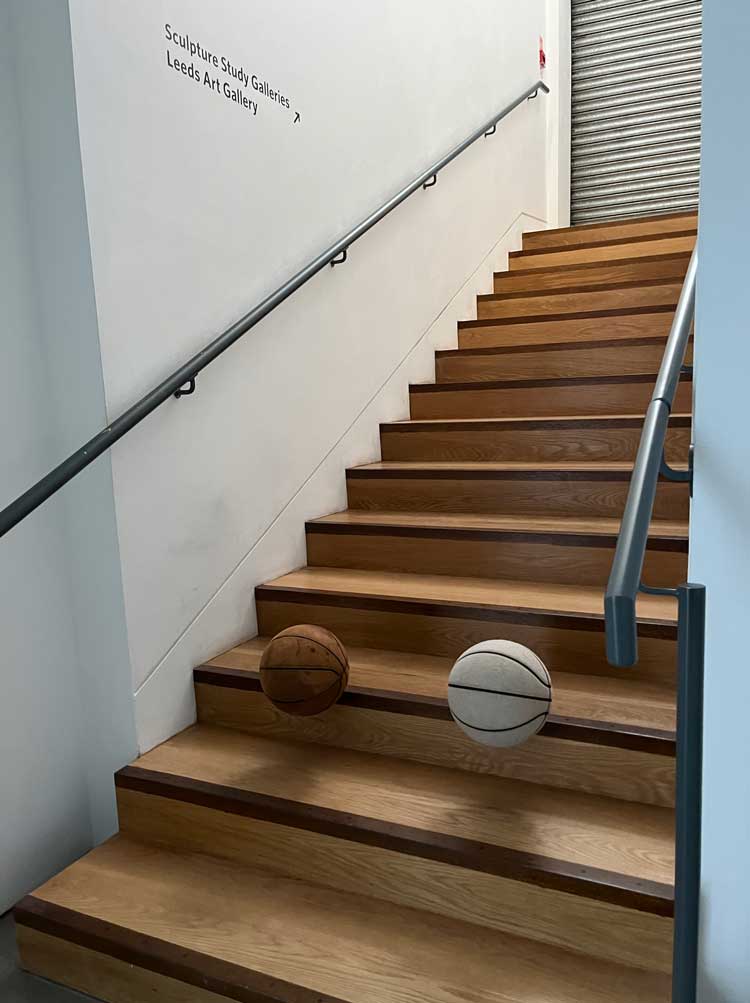
Michael E Smith, Untitled, 2023. Basketballs, stairs. Installation view, Henry Moore Institute, Leeds. Photo: Veronica Simpson.
Sillars says: “If you want to boil down his whole practice, it’s drawing ghosts. These things that have - beyond their own function, their design, their use history - they have something extra that’s often very human. With the basketballs, they might look like heads and, if there’s two of them, they look like eyes, but if you think of the hands that have touched them, the dirt that they’ve gathered, the bounces, the number of times they’ve been thrown between people, the relationships. As soon as you start going into that space, that’s what he’s interested in.”
While chatting with Sillars, I am eyeballing what looks like a furry sheepskin rug that has been hoisted two-thirds of the way up one of the white walls in this central gallery, with its hairy side facing away from us. Placed within the irregular frame of its underside is another box, this time a white one. I check the gallery guide: Untitled 2023, First Aid Cabinet, Hide. Ha ha, very funny: too late for first aid for this poor animal, stripped of its skin.
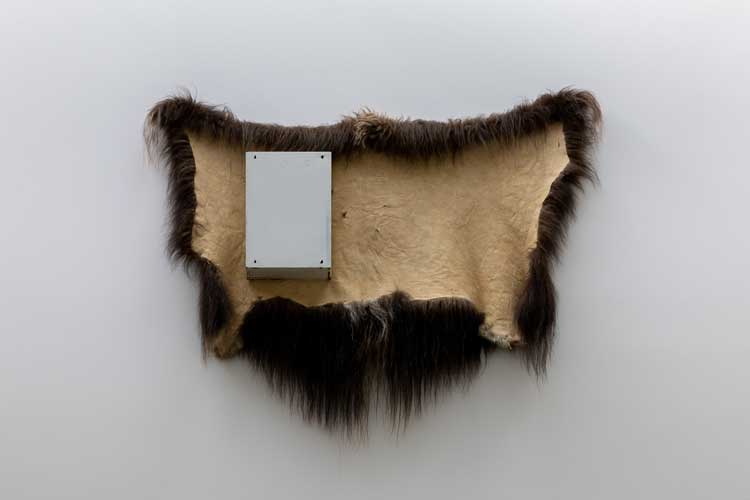
Michael E Smith, Untitled, 2023. First aid cabinet, hide. Installation view, Henry Moore Institute, Leeds.
The longer I spend in here, the more the work speaks to me, as do the spaces around the work, the scuffs, the qualities of neglect and decay that seep from them, but also the life in the rooms, in the objects. As I stand in the doorway of the third gallery, looking at that rug on the central wall, I feel suddenly physically disconcerted, as if I have been tilted backwards because the rug is on the wall and not on the floor. You question your own relation to its reality. The space between and around things speaks as loudly as the things themselves.
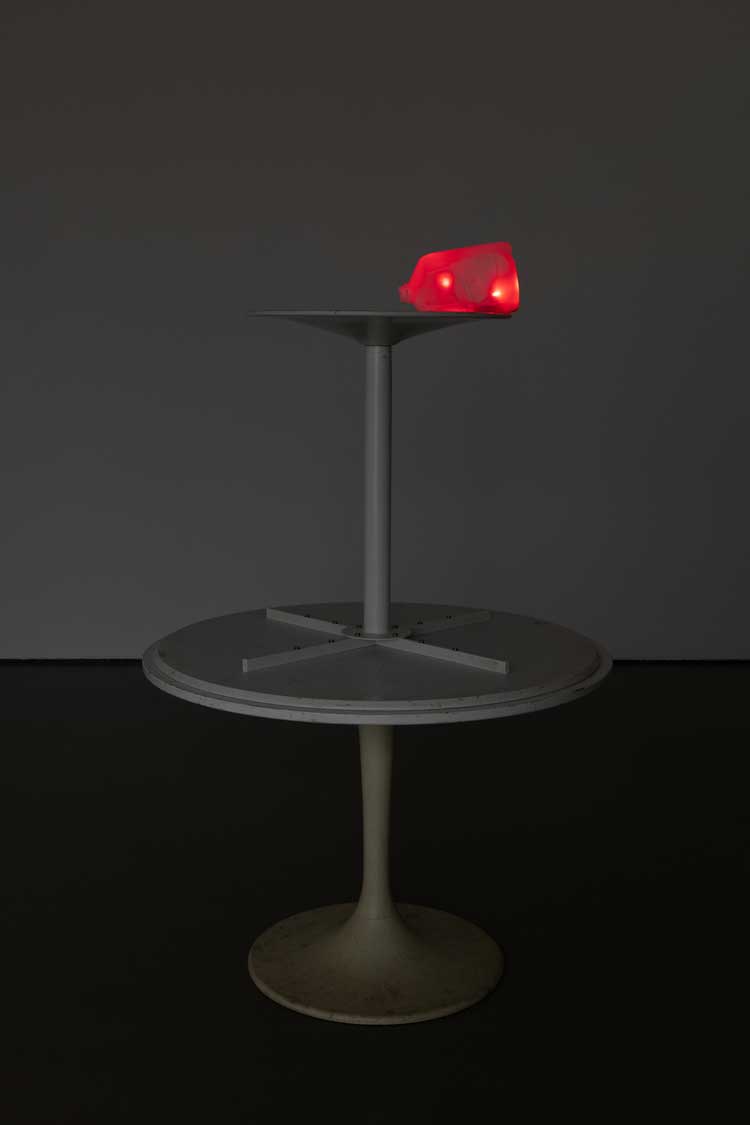
Michael E Smith, Untitled, 2023. Tables, milk jug, LEDs. Installation view, Henry Moore Institute, Leeds.
Also, in this gallery, two tables have been joined, one on top of the other, rendering them, obviously, redundant as tables, though the grubby fingerprints and food stains along their rims are evidence of a full past life. On top of this assemblage is a US plastic milk carton, empty but for some red LED lights. As ever, the lights are off, but, for some reason, the doors to an adjacent corridor, which houses the gallery’s lift, have been left open. The lift’s metal doors are shut, the lights are off, though the saffron walls of the lift corridor glow dimly. Why are the lift doors exposed, I ask Sellars: “I think it’s about evoking these atmospheric shifts: the collapse of public and private. There’s just a real honesty in his work. In the way that switching the light off, you just see it the way it is. There’s no illusion, it’s just the world, if it’s dark and gloomy, if it’s sunny, it’s just reality.
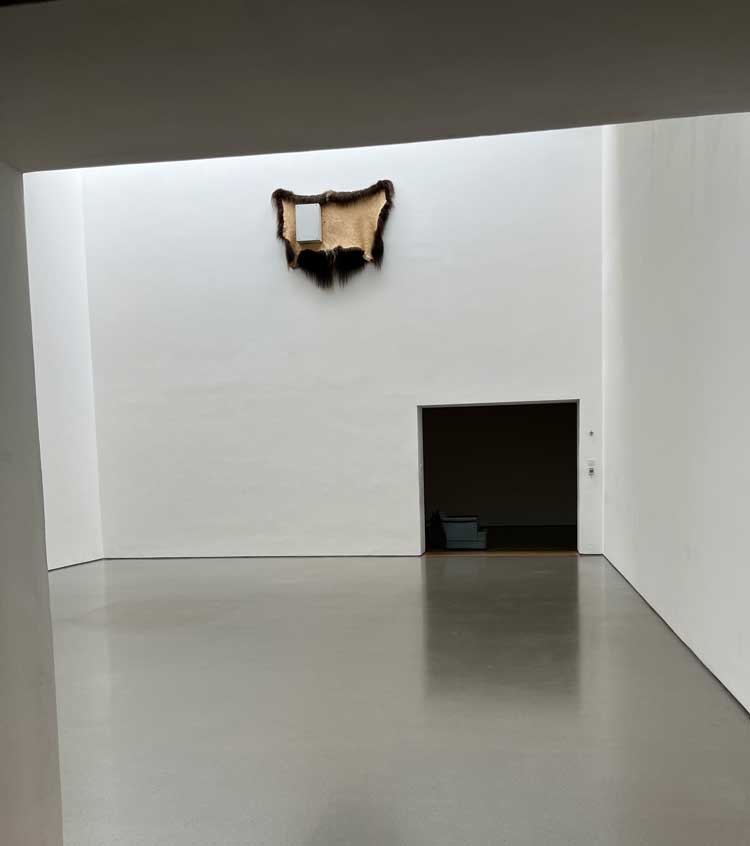
Michael E Smith, Untitled, 2023. First aid cabinet, hide. Installation view, Henry Moore Institute, Leeds. Photo: Veronica Simpson.
A hip-hop aficionado, Smith has often talked about the importance of music to his work, and there is a rhythm to his arrangements that speaks of the genre’s loose-limbed, rangy rhythms, the art form of the streets, filled with salvaged riffs and beats, stitched together with lyrics that speak of every shade of reality.
Sillars says: “While it’s a really sophisticated conceptual work that deals a lot with art history, with minimalism, and quite a lot to do with paintings, it’s also very generous in what it says about living and feeling and human traces and these kind of residues that we all leave or that are mapped on to the objects that are used on a daily basis. There’s a real precision to his work. But it’s also very open as to what you start to map on to it.”
I like it. I like the way it makes me see this building as I’ve never seen it before. I like that I may never see it the same way again, and the way it invites me to be honest in my appraisal. I also enjoyed the aura of anticipation that I sensed in the two young gallery assistants, as I strolled in alone. They were clearly poised (even eager) to talk to me about the work, should I wish to know more. There is so much we can all bring to it, from our own lived experience, past and present. I mention this to Sillars. He agrees: “The audience reaction has been brilliant. And the assistants, I get a lot of comments that it’s been their favourite show here.”
.jpg)
Michael E Smith, Untitled, 2023. Video, 2:07. Installation view, Henry Moore Institute, Leeds. Photo: Veronica Simpson.
As I leave, I’m reminded to check out the video over the reception desk. Here, Smith plays precisely 2:07 minutes’ worth of a bizarre video clip he found online of a webcam positioned over a dog kennel. The dog’s comfy, domestic detritus is scattered over the floor. The dog sleeps, then wakes, then ambles around repeatedly in his cell. Very existential. But it’s the positioning of this screen right behind the receptionist that gets us chatting – an awkward alignment; when people stand and stare at the video, it feels as if they are staring at him, he says. But he doesn’t mind. The awkwardness is all part of the work.